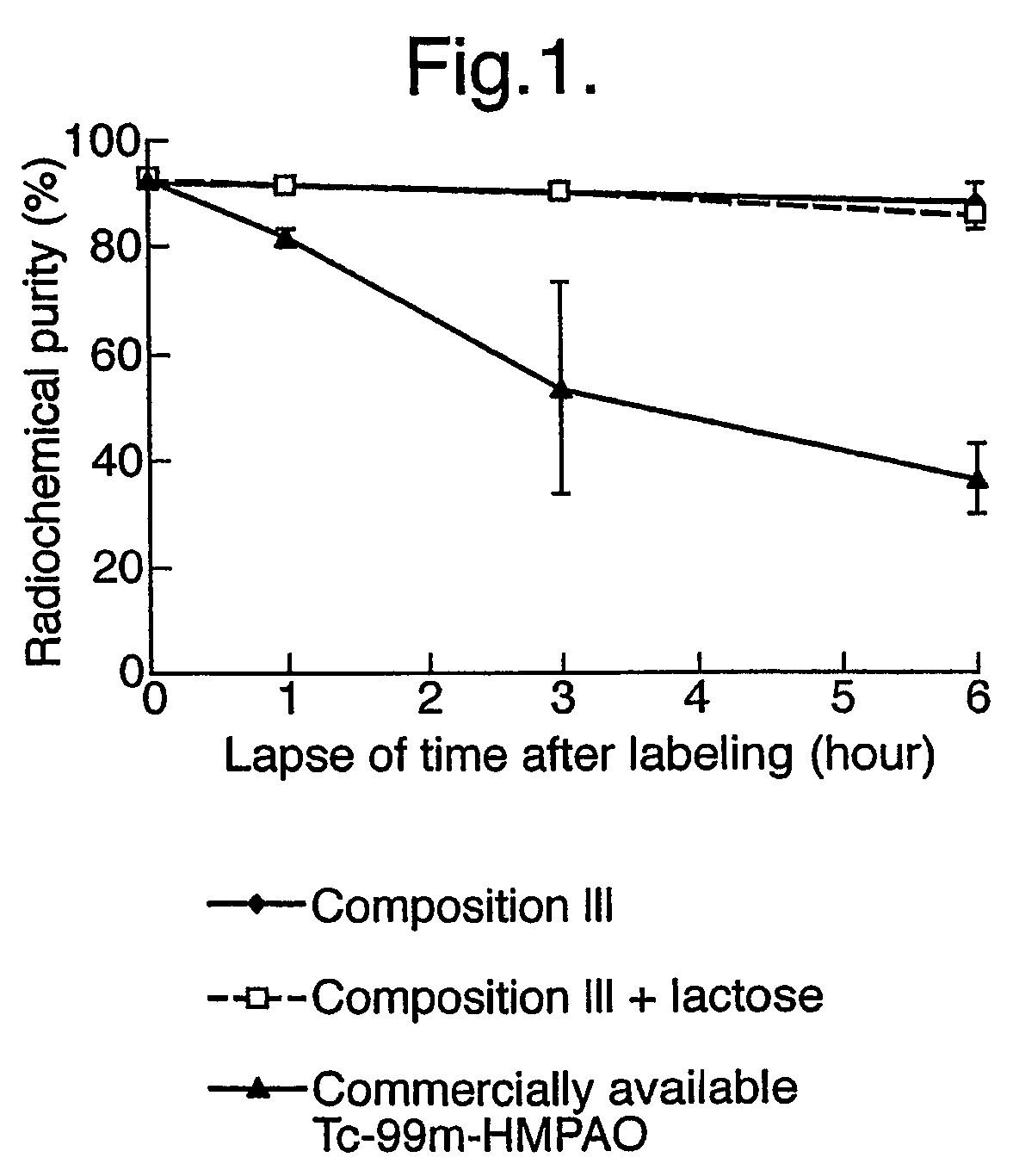Stabiliser for radiopharmaceuticals
a radiopharmaceutical and stabilising technology, applied in the direction of phosphorous compound active ingredients, inorganic non-active ingredients, therapy, etc., can solve the problems of radiopharmaceuticals, non-radioactive kits, radiopharmaceuticals, etc., and achieve the effect of stabilising radiopharmaceuticals and reducing the risk of side effects
- Summary
- Abstract
- Description
- Claims
- Application Information
AI Technical Summary
Benefits of technology
Problems solved by technology
Method used
Image
Examples
example 1
The Rcp of 99mTc-HMPAO Using a Single Stabiliser: Two Step Process (Comparative Example)
[0056]The radiochemical purity (Rcp) of 99mTc-HMPAO prepared using a commercially available kit (CERETEC™) for preparing 99mTc-HMPAO is 80% at one hour post-reconstitution, and the Rcp decreases thereafter with time. On the other hand, in the case of 99mTc-HMPAO stabilised with cobalt chloride, the Rcp 6 hours after radiolabelling is 80%. The following known medically acceptable compounds and additives were studied: ascorbic acid, sodium ascorbate, gentisic acid, gentisic acid ethanolamide, methylenediphosphonic acid (MDP), succinic acid, 4-aminobenzoic acid (pABA) and sodium 4-aminobenzoate (NapABA).
[0057]To each of ten vials each containing 0.5 mg of HMPAO and 4.0 μg of Sn2+ (stannous), was added sodium pertechnetate (1.48 GBq in 5 ml of saline) to carry out the radiolabelling. To each of 9 of the ten reconstituted vials was individually added the compound shown in Table 1 at a time of 2 minute...
example 2
Examination of Stabilisation of 99mTc-HMPAO by a Combination of Two Compounds: Single Step Process
[0059]The combinations studied were:[0060](i) ascorbic acid and hydroxymethanediphosphonic acid (HMDP);[0061](ii) sodium 4-aminobenzoate (NapABA) and methylenediphosphonic acid (MDP).
[0062]A composition comprising 0.5 mg of HMPAO, 4.0 μg of Sn2+, 1.0 μg of HMDP and 0.5 μg of ascorbic acid (Composition A), and a composition comprising 0.5 mg of HMPAO, 5.4 μg of Sn2+, 40.5 μg of MDP and 0.5 mg of NapABA (Composition B) were prepared. To each of A and B was added sodium pertechnetate (1.48 GBq in 5 ml) to carry out the labelling. After 3 hours, an aliquot was taken from each, and the Rcp measured by a combination of three chromatographic systems (stationary phase / developing solvent: silica gel / methyl ethyl ketone, silica gel / saline, filter paper / 50% aqueous acetonitrile).
[0063]The Rcp of 99mTc-HMPAO 3 hours after Tc-99m labelling was about 62% in the case of Composition A and about 80% in ...
example 3
Optimisation of Stabiliser Composition: Single Step Process
[0064]As shown in Table 2, six different sample compositions were prepared and stored in the dark at 4° C. One vial of each formulation was taken out at each time point (1, 7, 31 and 32-days storage), and sodium pertechnetate (1.48 GBq in 5 ml) was added. At 6 hours post addition of pertechnetate, an aliquot was taken from each vial and the Rcp measured by a combination of three chromatographic systems (stationary phase / developing solvent: silica gel / methyl ethyl ketone, silica gel / saline, filter paper / 50% aqueous acetonitrile). The results are shown in Table 2:
[0065]
TABLE 2Sample Compositions and Rcp of 99mTc-HMPAO 6hours post-radiolabelling (n = 1, *n = 3).CompositionIIIIIIIVVVIPreparationHMPAO0.50.50.50.50.50.5Conditions(mg)NapABA0.50.10.10.10.5—Sn2+5.45.48.18.18.18.1(μg)MDP40.540.561.061.0——(μg)HMPD————66.066.0(μg)Rcp (%) - 1 day86.479.582.273.884.8 ± 2.7*77.3 ± 5.5*after storage 7 days80.880.982.181.1——time32 days79.081...
PUM
| Property | Measurement | Unit |
|---|---|---|
| molar ratio | aaaaa | aaaaa |
| total volume | aaaaa | aaaaa |
| total volume | aaaaa | aaaaa |
Abstract
Description
Claims
Application Information
 Login to View More
Login to View More - R&D
- Intellectual Property
- Life Sciences
- Materials
- Tech Scout
- Unparalleled Data Quality
- Higher Quality Content
- 60% Fewer Hallucinations
Browse by: Latest US Patents, China's latest patents, Technical Efficacy Thesaurus, Application Domain, Technology Topic, Popular Technical Reports.
© 2025 PatSnap. All rights reserved.Legal|Privacy policy|Modern Slavery Act Transparency Statement|Sitemap|About US| Contact US: help@patsnap.com

